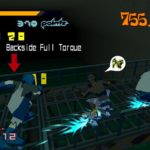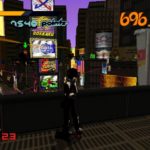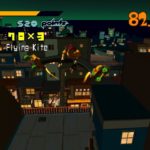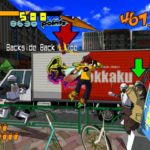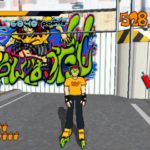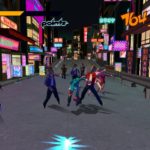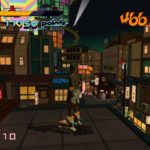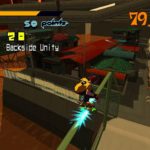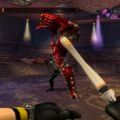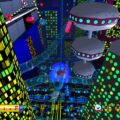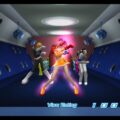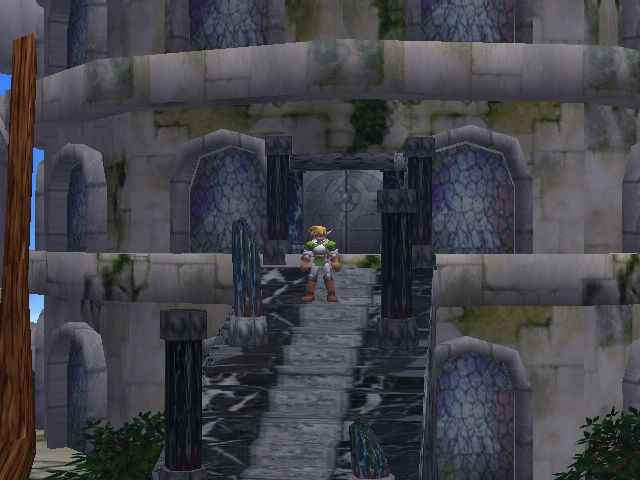Developer: Smilebit Publisher: Sega Release: 10/31/00 Genre: Action
Sega were on fire with the Dreamcast, releasing stunning arcade ports and original titles alike. There’s something to be said for your creativity being unleashed when your back is against the wall. And in the year 2000 that described Sega. With the PlayStation 2 looming as well as the GameCube and Xbox they had to entice gamers with strong software. While a lot of attention was lavished on Shenmue in my opinion Jet Grind Radio was the better game. Highly original, visually fantastic, and with gameplay to match Jet Grind Radio is one of the Dreamcast’s best games.
You can’t talk about Jet Grind Radio without mentioning the visuals. Jet Grind Radio was one of the first games to use cel shading for its stylized look. The thick outlines make the characters pop and give the game a cartoon look. The shadow effects during the different times of day are stunning as well. The game doesn’t coast on this technique however. Sega has gifted the game with a level of style most games would kill for. All of the characters are funky, including the various rival gangs and their logos. Each of the three districts of Tokyoto is visually distinct, from the densely populated shopping district of Shibuya to the eternal night of Benten.
And if you like graffiti Sega have gone above and beyond. There are 102 pieces of unique art you can find to paint the town. These come in three sizes and are absolutely incredible. At one point you could even go online and upload nearly any picture to turn it into custom art for the game. If that isn’t enough you can also create your own with the included editor, although good luck trying to create something decent.
The sound track combines nearly all styles of music, from hip hop to acid jazz and j-pop and never gets old. The US version of the game added some new songs featuring rock acts such as Rob Zombie and while they fit somewhat they become repetitive quickly. The overall sound design however is immaculate; hell even the voice acting is competent!
All of that praise is nice but how does it play? You start off with Beat as the lone member of the GGs. But immediately after you are challenged by Gum and Tab. These challenges, as well as the ones that follow, serve as tutorials for the game’s mechanics. You can grind on most surfaces like Tony Hawk as well as wall ride. All of these actions are simple and intuitive however they are let down by the controls. The controls have their quirks, some minor and some incredibly frustrating. Boosting for speed isn’t always responsive. It is annoying when trying to evade police but manageable. What is unforgivable is tying both spray paint and the camera to the same button. This makes no sense and hurts the game. You only use three buttons out of six; this is a massive oversight that should have been fixed.
Most missions drop you into a zone and task you with spray painting a specific number of designated targets. Spraying a target initiates a brief game of follow the leader. You follow the onscreen prompts to cover the target with whatever graffiti you’ve chosen. These range from small decals that require a single can to large murals that take time to fully cover. Every character has ratings in three categories: power, which affects your life bar, technique, which determines how well you perform tricks, and graffiti. Graffiti is a unique stat; the higher the stat the more complex the motions you’ll have to execute. In essence you want it lower unless you are seeking a challenge.
Although each level usually starts out trouble free it begins to escalate. Initially it starts with goofy police officers and dogs trying to pin you down. Captain Onishima will also show up to take shots at you. Eventually it escalates to paratroopers, shock troops, helicopters, and even tanks! Jet Grind Radio puts up a fight as the time limit becomes stricter and the tag spots harder to reach. You are also up against a resource limit; there are only so many health packs in each level. Failure in a mission forces you to restart from the beginning. For the later levels it is soul crushing, especially if you fail due to the wonky controls.
As much as I’ve harped on the eccentricities of the controls it is worth dealing with. Tokyoto is a fully realized world with incredibly strong level design. The missions throughout each district are only a small piece of each zone but they are all connected. The later levels actually force you to travel the length of an entire map which allows you to appreciate their design. While Jet Grind Radio can be challenging at times it is the good kind of difficulty. The plot is also compelling enough to keep you interested thanks to the game’s style.
In Closing
Jet Grind Radio is still one of the most unique games in the industry and fantastic. It is an absolute crime that it didn’t find an audience at release. The western version is actually better, with its larger soundtrack, extra missions, and even more graffiti. For as often as this goes on sale on PC for $5 or less there is no excuse to pass this up.


